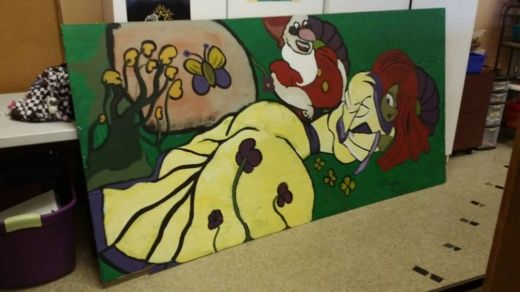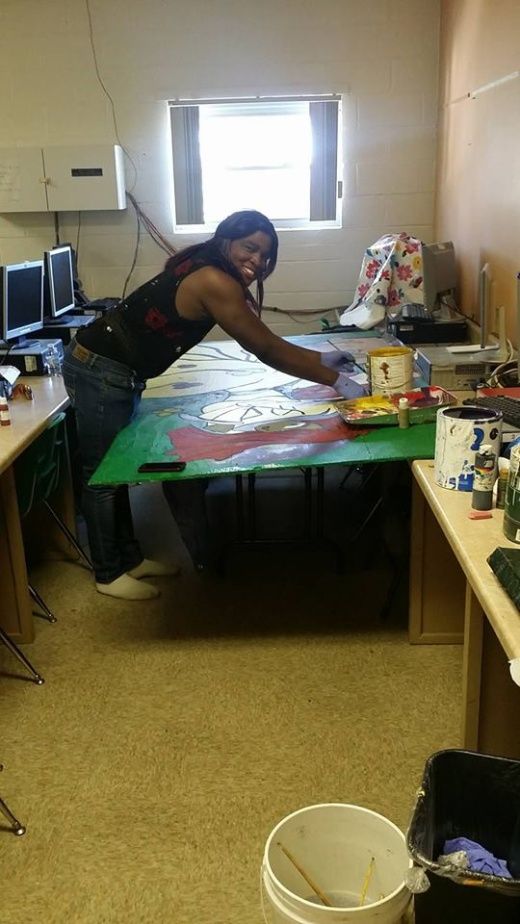Brandi Bledsoe teetered nervously at the edge of the bus platform with her aunt Angie and a gaggle of cousins, watching the trains and buses shuttle in and out of the cavernous terminal as they waited for her grandfather to pick them up. The Labor day weekend had just ended in suburban Cleveland, Ohio and as the sun set on the celebrating city, Brandi's heart quickened with dread, in anticipation of her grandfather's arrival.
RELATED:
Advocates Declare 'State of Emergency' for Trans Women in the US
Her grandfather had never seen her like this before, in a bright pink tank top, a patterned green skirt paired with black tights, her face painted defiantly with glitter makeup, all crowned with a red wig.
He had only seen her as Brandon, who he'd affectionately nicknamed "Popcorn."
“I love my grandad,” she had told her aunt last year, the summer when she came out to her family and announced that she had decided to live her life as a woman. Of her clan, her grandfather had been the most rattled by her transition.
“I'll just go as Brandon when I see him.”
But she hadn't expected to see him on this day. And as she and her aunt waited under a willow tree, she asked anxiously: “What do you think Grandad’s gonna do?”
His car pulled up minutes later. Brandi climbed into the backseat, sizing him up cautiously.
“Hi, Grandpa,” she said.
Her grandfather turned around, paused for what seemed like an eternity, and said: “Hi Popcorn, how are you doing?”
It was a joyous moment, a triumph for Brandi, reassuring her that she might yet put some distance between the life she led and the life she dreamed of.
And then, just like that, she was gone.
A month later, on October 8, a five-year-old riding his bicycle found Brandi's body in the driveway of an East Cleveland home, clad only in her underwear, her hands and feet wrapped curiously in white, plastic bags. She'd been shot in the chest.
Brandi was the 23rd transgender woman killed in the United States this year, the deadliest year ever recorded for such violence. Of these, Brandi's was not the most brutal, or the most jarring. She wasn't famous, or powerful, and she certainly wasn't rich. What she was, however, was this: a 32-year old Black woman trying to make a life for herself, whose death cast a dark and impenetrable cloud over those who loved her, and yet, cast a spotlight on the uniquely, horrific violence that menaces transgender women of color.
Of the 23 reported transgender deaths so far this year, 17 were Black. The numbers of transgender deaths have been rising steadily in recent years coinciding with the apogee of an economic crisis in the U.S. that is unlike anything the country has ever seen. In greater Cleveland, where more of the city's homeowners have lost their homes to foreclosure than practically any other city in the country, there have been four murders of transgender women, all Black.
A groundbreaking 2011 National Transgender Discrimination Survey (NTDS) report found that transgender people in the United States are nearly four times as likely to be living in extreme poverty, and Black transgender people are more than eight times as likely to be extremely poor than the population at- large. Similarly, transgender Latinx are seven times more likely than the general U.S. population to be living in extreme poverty.
“Mix race, mix class, mix gender, and it’s impossible to obtain housing or find a job,” Elle Hearns, the Organizing Coordinator for the Black Lives Matter network and a former organizer at GetEQUAL told teleSUR.
With their already meager opportunities depleted even more, transgender women are “forced into underground economies for survival, including sex work and drug sales, which place them at heightened risk for violence and sexual assault,” the NTDS survey wrote. Indeed, even when employed in more ‘formal economies’–as Brandi was–90 percent of transgender people interviewed by the NTDS had experienced harassment in the workplace and more than 26 percent lost a job because they were transgender or gender non-conforming.
The National Coalition of Anti-Violence Programs (NCAVP) reported that transgender women “experience a greater risk of death by hate violence than any other group” in the United States.
The justice system itself also represents a huge barrier to curbing anti-transgender violence. Even if they are not engaged in survival behaviors that are criminalized, transgender people who report to police that they have been victimized by physical or sexual assault, face the risk of being harassed or intimidated by law enforcement.
In fact, the NCAVP found that transgender people of color were 6 times more likely to experience physical violence from the police than the rest of the population.
And as a joint report by the Human Rights Campaign and the Trans People of Color Coalition made clear, of the 53 reported transgender murders between 2013 to 2015, not a single one was prosecuted or reported as a hate crime.
Ohio currently has no law in place that classifies gender identity as a protected class, and so violence against transgender people does not necessarily qualify as a hate crime.
That’s why to Hearns, the solution to this epidemic is not a mere shift of resources, but a dismantling of the very systems that both ignore and perpetuate this constancy of violence.
“There needs to be a larger conversation about dismantling transphobia,” she explained. “And the systems that systematically and structurally don’t pay attention (to), or organize resources (against this violence).”
“I think there's a lot of conditions in Ohio that exacerbate conditions of marginalized communities, like Black trans women,” Hearns continued. “In Northeast Ohio, in the Black economy, poverty, infant mortality rates, imprisonment and political fearmongering...all of these increase the murders of Black trans women
“This is startling,” she said, “truly an epidemic.”

Brandi's completed mural. | Photo: Courtesy of Angie Redding-Craggett

Brandi working on her mural. | Photo: Courtesy of Angie Redding-Craggett
The night before she was killed, Brandi posted photographs to her Facebook page of a night out on the town with a friend.
“I had been teasing her about her red wig," said her aunt, Angie Redding-Craggett, "and she went out and got another one. It was My L’il Pony bright lavender. (When I saw the photos) my plan was to send her a message and give her the hardest time,” she said.
“But I never got to do that.”
Angie and Brandi were close, spending a lot of time together since Brandi had moved to Cleveland from Omaha, Nebraska in 2011. Growing up as a homeschooled child with developmental disabilities, Brandi’s outlet was always her artwork, anime and drawings as flamboyant as she was, vivid and full of life.
“She liked drawing ladies,” her aunt recalled. “Colorful, strong women that she would draw.”
Whether Brandon or Brandi, she was warm, like the sun, and everyone who knew her revolved in her orbit, like planets seeking her heat. When Angie was diagnosed with breast cancer early this year, Brandi was the first one to visit her in the hospital.
Only months before her death, she’d found work at Home Depot, and was excited that her employer had agreed to issue her a name tag identifying her as Brandi, rather than Brandon.
“I remember her saying recently ‘Aunty, I’m a grown up!’ and I said ‘Yes you are,’” Angie recalled. “She was very proud. She had accomplished things people that aren’t ‘normal’ aren’t supposed to do.”
She’d moved into her own apartment and was already plotting her next move: art school.
And shortly before her death, she’d finished her biggest and most ambitious art project yet, a 6 by 10 mural at Angie’s workplace, the Malachi Center, a local community hub.
As Brandon, Brandi had visited her aunt every year growing up, and no one had an inkling that she’d been thinking about changing her gender identity. So when Brandi showed up at Angie’s door last July dressed to the nines in her new attire, Angie acknowledges that she was taken aback.
“I admit, in the beginning, I wasn’t encouraging of it, and at the back of my mind I thought this was just a phase,” Angie said in a phone interview.
But she gradually came to terms with her niece’s transition, although her main concern “was always her safety.”
Police say they have not made any arrests in Brandi’s murder. Her mural now adorns the community center where Angie works, and in the three weeks since her death, Angie runs into someone who knew her almost every day.
“‘I knew Brandi!’ they say. ‘She was so lovely, so sweet, so kind’, they all say to me,” Angie said.
“(When she transitioned) she was happy, just real happy. She had the attitude of ‘you might not like it, but I like it.'”
The memorial service for Brandi will be held Saturday in Cleveland and Angie hopes to find some comfort in meeting Brandi’s legion of friends in the LGBT community that she made in the last year.
Angie laments: “If I had known she’d be gone so soon...my acceptance would’ve come faster.”